2016’s HITMAN reboot was one of my favorite games of this console generation, so it goes without saying that I should be giddy with excitement for HITMAN 2. It’s with great unease, then, that I feel an inescapable sense of disappointment with this latest incarnation. Make no mistake: HITMAN 2 can only be described as more of a good thing. If you liked playing HITMAN, you’ll love playing HITMAN 2. Yet even considering how sleek and fun HITMAN 2 is, I can’t help but feel overwhelmed by the full package.
You see, HITMAN 2 is fundamentally the same game as its predecessor. You go to exotic locations, meet exotic people, and kill them with exotic means. But there’s one big difference: 2016’s HITMAN was an episodic game. 2018’s HITMAN 2 is not. This may not sound like a big deal, but here’s the rub: spacing out map releases over the course of numerous months was an incomparable pleasure.
Letting the enormity of the original HITMAN’s opening map, Paris, marinate in my brain allowed the game to age like a fine wine. I would teach myself new strategies, apply them to the follow-up map, Sapienza, and so on. Even when a locale I didn’t enjoy was released (i.e Colorado), I would dive in, applying the skills I’d learned in months prior while picking up fresh ones. Levels I would have otherwise shrugged off as “boring” suddenly had value because they presented new material.
Few games enthralled me through sheer replayability the way that HITMAN did. With equally large games looming over my shoulder this holiday season, I find myself frustrated that HITMAN 2 isn’t the bite-sized experience it was two years ago. If this were the case, it would certainly allow me to see-saw between HITMAN and the current consumer of every gamer’s time, RED DEAD REDEMPTION 2. All of this begs the question: Should all Hitman games be released piecemeal, full stop?
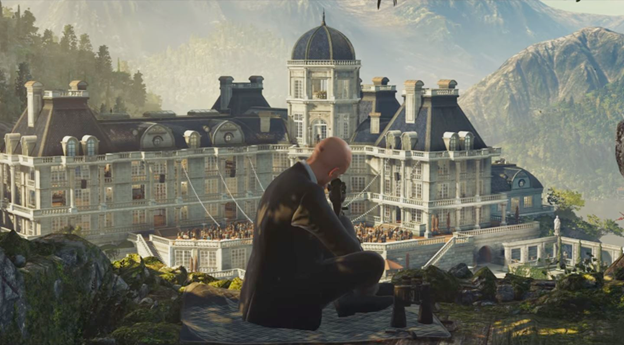
Standby…
HITMAN 2 opens with a short but expertly designed home-invasion-turned-assassination mission that elegantly introduces all of its core game mechanics, and works as a microcosm of the bigger game. The map is much smaller than any of those that follow, but the layers of interactivity are all there. You spy, infiltrate, gather intel, and plot and execute your assassination like a master killer. For anyone dying to get the HITMAN experience, but with just under an hour of free time, it’s kind of the perfect map.
All of this is to say, this introductory stage is not unlike the tutorial stage of 2016’s HITMAN (which is also conveniently included in this new game). The difference is that this is a sturdier standalone map that you might want to return to down the line. There are countless ways to execute your target, and the chic beachfront setting feels ripped straight out of a 007 film. Frankly, I could have spent another 10 hours replaying this stage, but the game almost demands that I move onto its first real map, Miami.
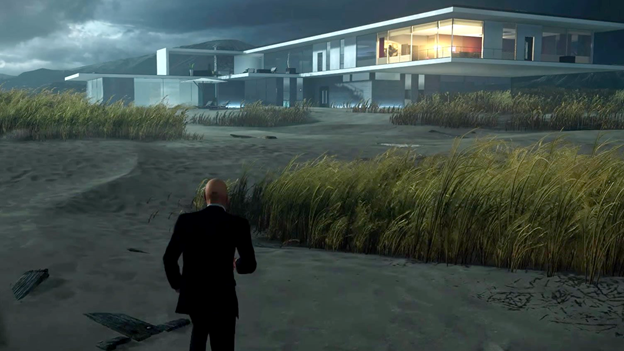
Tutorial, they say…
Miami is the gargantuan video game experience that really has to be seen to be believed. It’s labyrinthine in its winding corridors, floors, and restricted areas. A bustling crowd enlivens a high speed endurance race, and the drivers themselves drown out all noise as they rocket down the track. The additional quirk that Miami’s two targets are doing two completely different things (one is racing a supercar, the other is running a high-end tech expo next door) only makes the world feel all the larger.
Is Miami any different from 2016’s stand-out missions Paris, Sapienza, or Hokkaido? Beyond scope, not really, only that these latter maps were released months apart, rather than included in a single bundle. As a gamer with finite playing time, I really appreciated that. It justified my yearlong commitment to the game, constantly replaying the latest map in eager anticipation of the ensuing release. Despite spending a fraction of the time in a single session when compared to stealth sandbox like METAL GEAR SOLID, I was able to master locations and memorize routines, truly embodying the persona of Agent 47.
As each ensuing map ramped up the difficulty by increasing the number of restricted areas and limiting safety nets, the temporal gap that existed between levels encouraged players to practice, honing their skills before being ready to move onto their next locale. Since HITMAN 2 doesn’t try to change a design that wasn’t broken (you very well could call this game HITMAN 1.5), it also runs into the pitfall of inundating the player with content.
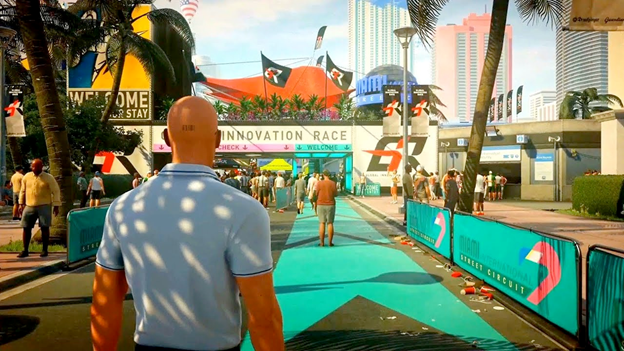
Donning my best Vin Diesel cosplay
Miami is not an easy level by any means, so wouldn’t it behoove developers to let players sharpen up before moving on? Instead, HITMAN 2 places me in the least ideal state of mind: I want to beat Miami, not so that I can try and beat it all again with a different approach, but simply to rush on ahead to see what’s in store for me next. Even though HITMAN 2 dwarfs its predecessor in terms of day one content, it somehow feels smaller. The game repeatedly reminds you that just because you beat Miami, the experience isn’t over. It goes without saying that this was never a statement HITMAN needed to issue back in 2016, if only for the reason that it initially only had one level.
What once felt like a hint of an incomplete product (or even the developers botching deadlines), now registers as a wise release strategy, a unique spin on presentation that actually made the game feel larger. After all, a game like HITMAN is truly the sum of its parts, and if gamers aren’t encouraged to study each individual cog, they’ll never appreciate the overall machine. I surely wouldn’t have been as extra in executing my Paris targets during the months of waiting for Sapienza if I’d already had that second map to move onto afterwards. This calls to mind the games of my childhood, where endlessly replaying a five-minute demo could be as fun as playing the final product.
We’ve spent so much time assuming that an episodic game is only released in bits and pieces because developers don’t have the funding (or manpower) to pump out the full game at once, but what if this strategy aids the presentation? How different is a constantly single player experience from that ever-shifting sea that is the service game? I’d wager that HITMAN was the first hardcore gamer experience that greatly benefitted from this treatment. Not every game demands to be replayed ad infinitum—Bethesda and Rockstar surely don’t design games this way—but what if we utilize the literal gap in time between releases as part of enriching the experience?
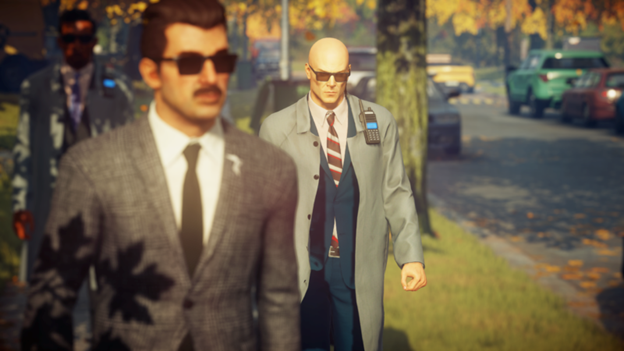
This look is the deadliest weapon in 47’s arsenal
HITMAN 2 is a mechanical improvement in all respects. It flows smoother. The voice acting is cleaner. The humor is as sardonic as ever. Guns blam better and junk is even more fun to hammer-throw into bystander’s heads. But it’s too much at once! If 2016’s HITMAN was a leisurely five-course meal at a Michelin-star restaurant, HITMAN 2 is a hot dog eating contest.
If pacing is an integral component of modern game design, I think we should be having a discussion about the literal pacing of a game’s release. Why give me everything at once when spreading it out actually enriches the experience? There’s experiential bliss to be found in savoring a game. While I could very well knock out all of HITMAN 2 in a seven-day binge, I really don’t want to hate myself, or this lovely game, just because that’s the way its developers decided to serve it. Make no mistake, this plate is still a delicacy, but one that is entirely dependent on how you consume it.


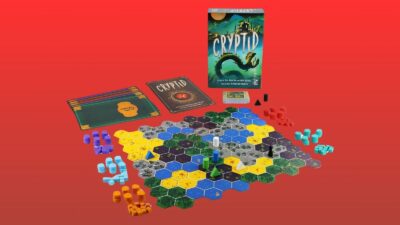
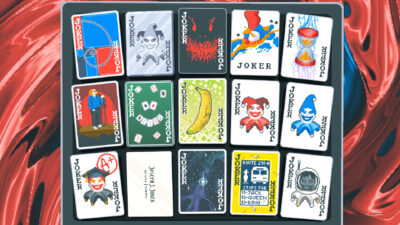
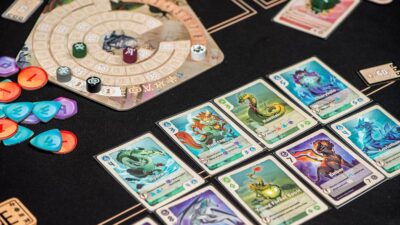
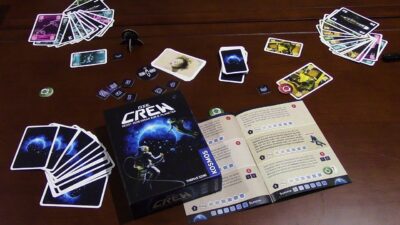
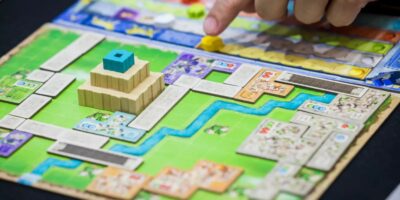

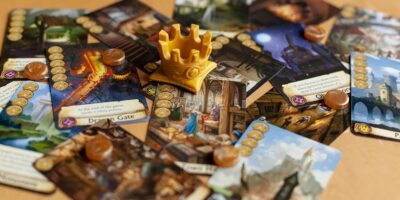


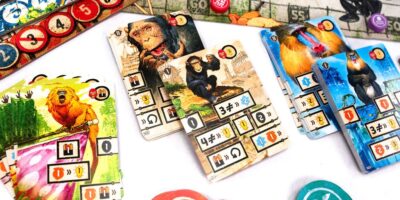




Comments